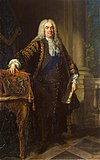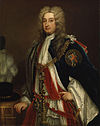Richard Lumley, 2nd Earl of Scarbrough
Appearance
Sir Godfrey Kneller, Bt.[1]
Richard Lumley, 2nd Earl of Scarbrough Earl of Scarborough. He committed suicide by shooting himself in the head.
Early life
Lumley was the second son of Richard Lumley, 1st Earl of Scarbrough. He was educated at Eton College in about 1702 and was admitted at King's College, Cambridge in 1703.[2]
Career
At the
1st Dragoon Guards in 1713. He told against a Court amendment to the Address on 10 April 1713, and voted on against the French commerce bill on 18 June 1713. At the 1713 British general election he was returned again for Arundel. He was concerned about the movements of the Pretender and campaigned for his removal from Lorraine. He spoke and voted against the expulsion of Richard Steele from the House.[4] In 1714 he was appointed Lord of the bedchamber to the Prince of Wales in September 1714 and became Master of the Horse to the Prince of Wales in November 1714.[4]

In 1715, Lumley was
Privy Council on 15 June 1727.[3] He gave up his court post in 1734 and was promoted to major-general in 1735 and lieutenant-general in 1739. In 1739, he was one of the founding governors for the Foundling Hospital in London
.
Death and legacy
Lord Scarbrough committed suicide by shooting himself through the
roof of the mouth on 29 January 1740, aged 53. At the time of his death it was rumoured to have been brought on by a mental disorder he developed from a knock on the head when he had an accident in his carriage a few days before.[4] There was also a rumour that he had killed himself because of a betrayal of trust. The rumour ran that he had confided a secret of State to the dowager Duchess of Manchester whom he had been about to marry, and that she had then told this secret to others. When word got back to the king of the source of the leak of the secret, Scarborough killed himself.[5]
Lord Scarborough was buried on 4 February 1740 in the Grosvenor Chapel in South Audley Street, Mayfair. Scarborough's titles passed to his brother, Thomas.
References
- ^ National Portrait Gallery
- ^ "Lumley, Richard (LMLY703R)". A Cambridge Alumni Database. University of Cambridge.
- ^ a b c Milner, Edith (1904). Records of the Lumleys of Lumley Castle. George Bell and Sons. p. 150. Retrieved 17 April 2020.
- ^ a b c d e Watson, Paula. "LUMLEY, Hon. Richard (1686-1740)". historyofparliamentonline.org. Retrieved 17 April 2020.
- ^ Milner, Edith (1904). Records of the Lumleys of Lumley Castle. George Bell and Sons. pp. 166–67. Retrieved 17 April 2020.


